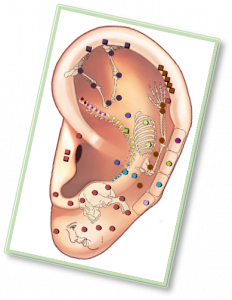

- 14 CE Hours for ARCB & NCBTMB
- Prerequisite: Basic Ear Reflexology, hands-on or online.
The ears are an amazing reflex area for rapid and profound relaxation and pain reduction, especially for most musculoskeletal issues. Working with two Somatotopic Ear Maps, Functional Points and Master Points, you will see remarkable results for a variety of different issues your clients may be dealing with. You can add Ear Reflexology into your Foot and Hand Reflexology session, and/or combine it with other modalities.
In addition to imaging the entire body, ear reflexology has many other ear points for us to work with. In this intensive seminar you will learn what influence the combined application of Master Points and Functional Points has on the body. This deep insight into Ear Reflexology will enable you to integrate these targeted applications into your reflexology practice.

- 14 CE Hours for ARCB & NCBTMB
- Prerequisite: Basic Ear Reflexology, hands-on or online.
During This Power Packed Hands-On Class
You will work with the Advanced French & Chinese Reflex Maps and learn the Auricular Representation of the Nervous System. Gain deeper understanding of the 10 Master Points and their special significance, as well as new knowledge of Functional Points that are relevant for learned protocols.
You will gain confidence in the use of powerful protocols for neurological and stress related disorders, such as Parkinson's Temor, Multiple Sclerosis, Chronic Fatigue Syndrome, Post-Traumatic Stress Disorder, Cerebral Palsy, and Stroke.

- 7 CE Hours for ARCB & NCBTMB
- No Prerequisite
Ear Reflexology is originally based on the ancient Chinese practice of acupuncture with only very few ear points known that were not organized somatotopically but in a non-specific pattern. The first somatotopic ear map was developed in 1957 by the French physician Paul Nogier and is based upon the concept of an inverted fetus orientation.
Today we are working with a combination of French and Chinese Reflex Maps. The ears are an amazing reflex area for rapid and profound relaxation. They are also remarkable for pain relief in the jaw, neck, all ten zones of the shoulders, all ten zones of the lower back, lumbar spine, sacrum, coccyx, hip, and sciatic. You can integrate Ear Reflexology easily into your Foot and Hand Reflexology session and combine with other modalities.

- 2 half days, 6 Hours Total
- Live Online or Pre-Recorded
- Plus a follow-up meeting with course instructor after course completion.
In this online course you will receive an introduction to Ear Reflexology and how you can use it easily and effectively on yourself and on your clients. Three individual Ear Reflexology Maps will be introduced – the map of Musculoskeletal Ear Points, the map of Organs & Neuroendocrine Ear Points and the map of the Master Points.

- 7 CE Hours for ARCB & NCBTMB
Anxiety and depression can be found in every country and in every age group. The number of people affected and the suicide rate, especially among young people and young adults, has risen dramatically in some countries in recent years.
Ear Reflexology is originally based on the ancient Chinese practice of acupuncture with only very few ear points known that were not organized somatotopically but in a non-specific pattern. The first somatotopic ear map was developed in 1957 by the French physician Paul Nogier and is based upon the concept of an inverted fetus orientation. Today we are working with a combination of French and Chinese Reflex Maps.

Ear Reflexology is based on the ancient Chinese practice of acupuncture. Originally only a very few ear points were known, and they were not organized somatotopically, but in a non-specific pattern. The first somatotopic ear map was developed in 1957 by the French physician Paul Nogier and is based upon the concept of an inverted fetus orientation. Today we are working with a combination of French and Chinese Reflex Maps.
The ears are an amazing reflex area for rapid and profound relaxation and pain reduction, especially for most musculoskeletal issues. Working with two Somatotopic Ear Maps, Functional Points and Master Points, you will see remarkable results for a variety of different issues your clients may be dealing with. You can add Ear Reflexology into your Foot and Hand Reflexology session, and/or combine it with other modalities.

- 14 CE Hours for ARCB & NCBTMB
- Prerequisite: This seminar is open to all qualified Reflexologists. Because of the practical nature of the training, available seats are limited. A workbook is also included in the course cost.
Ear Reflexology is originally based on the ancient Chinese practice of acupuncture with only very few ear points known that were not organized somatotopically but in a non-specific pattern. The first somatotopic ear map was developed in 1957 by the French physician Paul Nogier and is based upon the concept of an inverted fetus orientation.